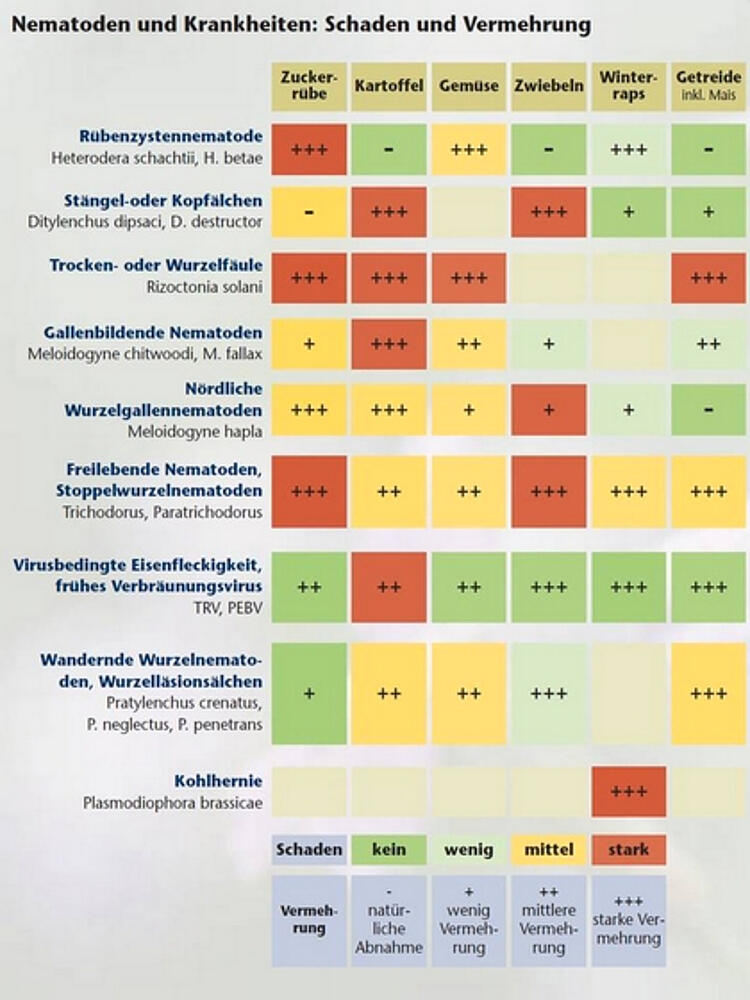Many diseases and pests may multiply unnoticed in several major crops, without damage to the stand becoming immediately obvious. The build-up is only noticed in the succeeding crop. With targeted catch crop cultivation, the build up of significant parasites can be combatted.
The most important pests are introduced below:
Free-living nematodes: An increasing problem in cereals - Especially on sandy soils, damages such as sparse or stunted cereals or poorly germinating cereals after winter are frequently noticeable across whole areas. Several free-living nematodes, such as Pratylenchus spp. and Trichodorus ssp., are the culprits. In other plant species, such as winter rape and maize, only moderate damages are diagnosed, but often it is precisely these crops that help free-living nematodes flourish and multiply. Even on "better" soils, on which these damage symptoms are much less obvious, secondary infections can arise from various fungal diseases. In particular the oil radish varieties CONTRA and DEFENDER can, compared to yellow mustard, significantly reduce the distribution of all free-living Pratylenchus nematode subspecies in catch crops.
The share of rapeseed in crop rotation is limited mainly by Plasmodiophora brassicae, the causal agent of clubroot disease. If a relatively narrow range of crops are rotated, the pathogen population goes up very swiftly. Since there have been only a few resistant strains to date, special care must be exercised in selecting the catch crop. Phacelia is not a host plant for this parasite. The oil radish varieties COLONEL, DEFENDER and CONTRA show no symptoms of clubroot infection - they evidently prevent the clubroot from multiplying, and are therefore also suitable as a catch crop in rapeseed crop rotation.
An active reduction of clubroot is, however, not possible.
In sugar beet crop rotation, problem number 1 is still Heterodera schachtii - the beet cyst nematode. Yield losses for sugar beet can reach up to 45 percent. Resistant oil radish and mustard varieties can clearly mitigate the situation. Their root secretions are highly attractive to the nematodes, inducing the larvae to hatch quickly from the cysts in the soil and migrate into the roots of the mustard and radish, where they try to establish their nutritive tissue.
The resistant varieties, however, offer the nematodes no adequate source of nutrients.
The migrating larvae starve or develop only into males. The life cycle of the nematodes is thus broken and the nematode population in the soil is actively reduced. In a long-term study by the Federal Biological Research Centre in Munster no build-up of nematode strains was discovered, even after 20 years of growing yellow mustard (MAXI variety). Admittedly, nematode-tolerant sugar beet varieties in areas with infestations of beet cyst nematodes do not respond with significant drops in yield, however, even nematode-tolerant varieties do produce higher yields, when the rate of nematode infestation is lower. Since the nematode population is not reduced by the tolerant beets, planting nematode-resistant catch crops is the safest strategy here for reducing nematodes in the long term and for achieving consistently high yields.
The deep roots of the resistant mustard and oil radish varieties also combat the nematodes in the lower soil layers, where more than 50 percent of the nematodes are found.
Ditylenchus dipsaci, the stem nematode, is a growing problem in sugar beet. So far, there are no control measures against it.
The oil radish varieties DEFENDER, CONTRA and COLONEL are not among the host plants, and so do not help the pest spread.
You can combat nematodes most effectively by sowing into into warm, moist soil, as the beet cyst nematodes are still active and hatching then. A sufficient number of plants (yellow mustard 25 kg/ha, oil radish 30 kg/ha) and a good root penetration of the soil ensure the roots can be reached easily by the nematodes.
Varieties with higher resistance (resistance rating 1) are more efficient in controlling nematodes. In addition, rapid initial growth and a delayed tendency to flower, as well as rapid and vigourous root growth, support successful control. Effective weed suppression is also important for combatting free-living and gall-forming nematodes, as these can multiply in many weeds.
